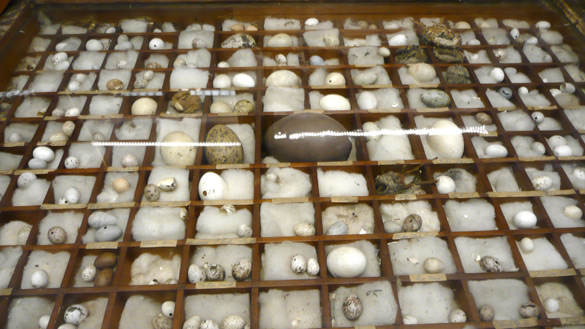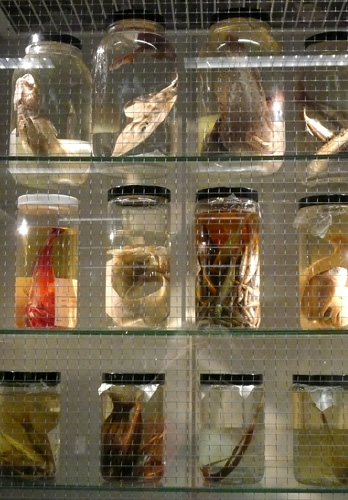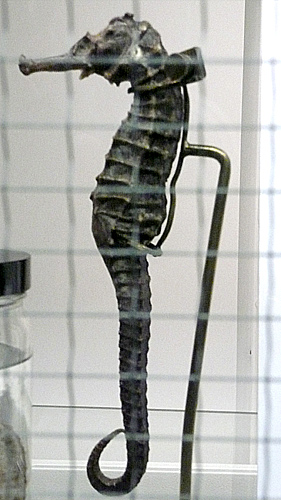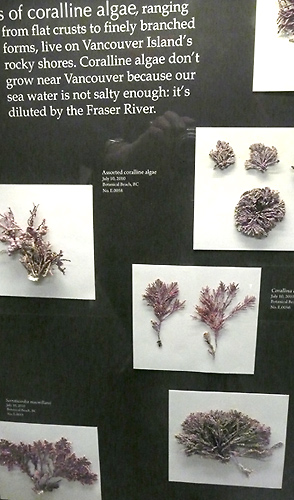Beaty Biodiversity Museum – 6

Next in our walk through the Beaty came the sections with small animals and birds in their skins with fur or feathers that are laid down in rows upon rows on shelves inside glass-doored display cabinets. I found these quite disturbing to look at and skimmed past these while asking myself, why is it harder than looking at the trophy heads and the skulls? This collection of eggs are a delight though (sorry about the reflections).


Somewhat disturbing too are the many forms of fish life preserved in jars of alcohol, looking much like pickles. I love the abstract image of “windows” containing warmly backlit rows of preserving jars from small to huge. It was challenging to photograph closeups through the wired glass but then I didn’t want to look too closely anyway. Husband did capture this delightful seahorse, unpickled. I used to think that was an imaginary fairytale creature.

Then there is the wonderful Herbarium. Seeing all the lichens so soon after I’d done some posts on them was serendipitous but I’m quite disappointed that I was unable to capture photos of their amazing variety because of the reflections on the glass. Of course only a small selection in any of the collections are on display. There are numerous drawers, also glass covered, that one could pull out to examine the contents – a researcher’s dream and an awesome record of biodiversity, but just too too much to see in one visit!
Coming soon and the last in this longer-than-planned series are the fossils, always a favourite of mine.
April 8, 2011 in Canada and BC, Environment, Nature, Photoworks by Marja-Leena
Especially like the eggs–a nurse my husband used to work with decorated her house with Victorian collections (great little boxes and domes.) I always liked to go stare at the eggs…
She also made sumptuous costumes for her child at Halloween. You definitely felt that she ached to live in a different time.
Marly, Victorian collections sound unusual these days unless you’re in the UK. I remember making a few Halloween costumes long ago but just quick and easy ones, though I’d feel a wee guilty I didn’t try harder – did you, with your family?
I’d feel much the same as you about the pickled specimens. The eggs are wonderful.
I think some were from Europe… but some from the U. S. Lots of stuffed animals on ornate mounts, lots of egg cases.
My mother made some wonderful costumes–medieval hats and capes and bloomers and fancy gowns. We still get a lot of use out of a huge dress-up box. My daughter often has a large number of friends over, and sometimes they still dress up–and they’re mostly 19. And my son of 13 uses it for Halloween and school spirit days. We have many gigantic hats…
I’m glad you came by and made that Clive-comment! Interesting.
Susan, everyone likes eggs, I think, and they do look lovely displayed this way. Now this is making me think of Easter….
Marly, I wonder how many people still have these kind of collections. How lucky you were to have a mother who made such rich things and you still have the costumes. I’d love to peek into your dress-up box. Ours was more modest though well-used by my children in their day but the granddaughters haven’t been as interested in it, preferring fancier things. It is interesting to see how imaginative play in childhood translates into creative writing and art, in your case for sure, and one of your daughters as I recall. Oh, and I sincerely meant it about the Clive thing…
These biodiversity posts are amazing, Marja-Leena. They remind me of a time when I wanted to be an archeologist. Then when I discovered the field of paleontology, my family couldn’t keep me out of the Senckenberg museum (here’s the link http://www.senckenberg.de/) Here’s where I have to admit that I clicked on the photo of the pickled specimens in the hope that it would enlarge …
Rouchswalwe, glad you enjoyed these, and sorry my photos don’t enlarge. The young often have a fascination for archaeology and even more for paleontology, thanks maybeto some movies that have romanticized these fields. The reality is they are a lot of hard work in the field and museums benefit and are really a fabulous resource for the rest of us. Strangely, I almost like them more than art museums.